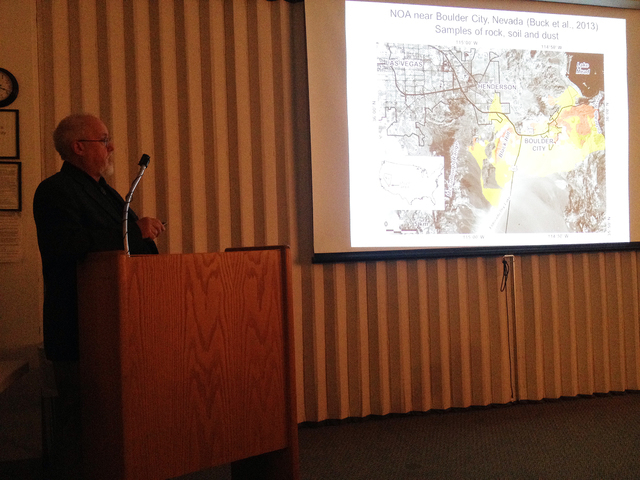Asbestos study authors share their concerns
Despite the lead agencies in charge of the Interstate 11 project telling Boulder City residents that naturally occurring asbestos is no longer an issue, the two UNLV professors who originally discovered it said the risk is still very much there.
During a public meeting at the Boulder City Library Tuesday night, professors Brenda Buck and Rodney Metcalf, along with David Berry of the Environmental Protection Agency, shared their research with about 50 people in attendance.
Berry talked about four case studies where naturally occurring asbestos was found around the world, including Libby, Mont., where more than 400 people died from asbestos-related diseases linked to the mines operated from the early 1920s until 1990.
“Asbestos is a very small particle that can remain in the lung for essentially a lifetime,” Berry said.
A few years ago Buck, who specializes in medical geology, looked through data from the Centers of Disease Control and Prevention and noticed an increase in asbestosis and mesothelioma throughout Clark County.
She asked members from the University of Hawaii Cancer Center to look through the Nevada Cancer Registry for mesothelioma cases. After they ran the numbers, Buck realized there was a reason to be concerned. And in 2012, she and Metcalf discovered fibrous minerals in the McCullough Range in Henderson. The discovery only added to her concerns.
She said she began to write up her data when the Nevada Health and Human Services Department denied her access to its cancer registry data.
“They averaged mesothelioma for the whole state, and they said there was no environmental issue,” Buck said.
The problem with the department’s methods, according to Buck, is that grouping numbers from the entire state dilutes the numbers strictly for Clark County.
“Our argument is, if they’re right or if we’re right, why not let the data go to peer review?” she asked. “Let the world experts in mesothelioma decide who’s right. I felt threatened at that point.”
Since the department denied her request, Buck said she and Metcalf quietly conducted their research in Boulder City. They didn’t tell anyone about it until it was completed, in case someone tried to prevent them from publishing their work, she said.
“We looked at rocks, we looked at soil, we looked at dust we collected off cars and boots,” Metcalf said. “In this particular instance, everything we checked had it.”
The two professors discovered concentrations of the naturally occurring asbestos in different parts of town, including the Boulder City Horseman’s Association, as well as King Elementary School. Some of the fibers found near the school were winchite and richterite, the same ones discovered in Libby, they said.
Buck and Metcalf also believe the winchite and richterite blew into Boulder City from Arizona.
“What we don’t know is how exposed they are,” Metcalf said. “We do know the hazard is there, but we don’t know the full level of the risk.”
One of Buck’s main concerns is Southern Nevada’s climate, which can blow naturally occurring asbestos particles from Boulder City into the Las Vegas Valley. Metcalf and Buck also discovered actinolite fibers in the Nellis Dunes, approximately 22 miles from Boulder City. Since actinolite was not known to be found in the Nellis Dunes area, they determined it had blown in from Boulder City.
“Which means it would be quite easy to blow into the entire Las Vegas basin,” Buck said. “This is not just a Boulder City issue, this is a Southern Nevada issue.”
Buck previously said she was encouraged by the Nevada Transportation Department and the Regional Transportation Commission looking for solutions to reduce the amount of exposure while the Boulder City bypass was constructed, but she still has concerns.
The agencies said they plan to thoroughly wet work areas, avoid the overfilling of work trucks, and reduce driving speeds in work areas to minimize the amount of dust during construction.
Three types of monitors, including some outside of the construction site, a few on site, and personal monitors that some workers will wear will be used to help determine the amount of asbestos in the air.
“It will be very interesting to see what kind of numbers they do get as they continue,” Buck said. “But right now it doesn’t really look great for those of us who live here and breathe this every day.”
Boulder City resident Ron Milne asked about the effectiveness of the mitigation measures, as well as the health of those adults who grew up in Boulder City and might have been exposed to the naturally occurring asbestos.
“Why not take the grade school graduating classes year after year and try to hunt those rascals down?” he said.
According to Berry, an asbestos-related disease can begin anywhere from 10 to 40 years after initial exposure, depending on how much exposure is in the system.
The Nevada Transportation Department worked with the California Transportation Department about mitigation measures with naturally occurring asbestos since the state does not have its own regulations.
Metcalf applauded the agency for going above and beyond what the law required, but he noted that California’s regulations are 20 years old.
“It still carries a risk,” he said. “I wouldn’t call that safe. I would call that a risk that we’ve decided to accept.”
According to the Transportation Department, naturally occurring asbestos is found in 35 of the 50 states, including 44 of California’s 58 counties. But Buck said comparing Nevada to California is much more complicated than simply looking at the numbers.
“A lot of the sites in California have the less hazardous chrysotile material, and you really need to look at the environment,” she said. “A lot of those sites (in California) are also in the north where there are trees and grass. They don’t have that dust that we have. Because it’s so arid here, that makes me concerned.”
Contact reporter Steven Slivka at sslivka@bouldercityreview.com or at 702-586-9401. Follow @StevenSlivka on Twitter.
















